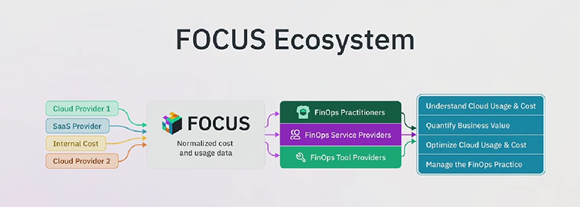FinOps Open Cost and Usage Specification (FOCUS) 1.2
A central part of the news stream at this year’s FinOps X conference in San Diego this week, the FinOps Foundation has detailed version 1.2 of the FinOps Open Cost and Usage Specification (FOCUS).
FOCUS in an open specification for cloud cost and usage data.
This release introduces support for SaaS and PaaS billing data, invoice-level reconciliation and multi-currency normalisation.
The foundation wants to establish FOCUS as the “unified billing format” across today’s Cloud+ environments.
What is Cloud+?
Cloud+ is a notion of FinOps measurement laid down by the FinOps Foundation itself to extend the realm of FinOps to not only focus on cloud spend and technology, but to also embrace the cost management of SaaS services, datacenter costs, software licensing considerations and more.
The foundation says that FOCUS 1.2 unifies Cloud+ reporting for FinOps practitioners by folding SaaS and PaaS billing data into the same schema as core cloud spend.
It also introduces an invoice ID column that links each row directly to provider invoices, which is said to help by streamlining charge-back and month-end close and also sharpen cost allocation with new billing account and sub-account granularity.
Three new providers also announced support for FOCUS 1.2, including Alibaba Cloud, Databricks and Grafana.
“As organisations increasingly manage complex, multi-cloud and SaaS-heavy environments, FOCUS 1.2 delivers the standardisation they need to understand, allocate and optimise spend across more technology platforms,” said J.R. Storment, executive director of the FinOps Foundation. “This release reflects the rapid expansion of the FinOps practices managing SaaS and PaaS spend alongside cloud over the last year.”
As reported in the State of FinOps 2025, many Practitioners are now working in a Cloud+ era where they are applying FinOps Principles to Cloud+ Scopes of technology cost and usage data from SaaS tools, licenses, private clouds, datacentres, AI spend and other sources. FOCUS provides a common format to unify billing data from these differing Scopes of technology spend.
FOCUS version 1.2 was ratified by the FOCUS Steering Committee to satisfy use cases spanning SaaS, PaaS and cloud billing in one schema, so a single dashboard or SQL query now covers FinOps practitioners’ scope of responsibility and reduces potential for duplicate charges.
Avoiding overcharges
FinOps users can also analyse credit and token purchase patterns to confirm commitments match demand. Users can “track burn-down” daily, forecast exhaustion and avoid surprise overages, while they can also rank charge categories that drive token consumption and target high-consumption drivers.
According to the FinOps Foundation, users can, “Compare discounted vs. list token rates to quantify contract savings and identify future optimisation opportunities. Convert mixed-currency datasets (e.g., USD, EUR, tokens) to a single currency for budgeting and P&L analysis, with auditable exchange rates. Associate every charge, credit, or refund to its provider invoice ID. Calculate cost-per x (e.g., GB stored, request, user) across providers, expose high-density spend and prioritise savings opportunity areas.
FOCUS is in its third year of development and it has gained adoption by numerous Cloud Service Providers, including AWS, Microsoft, Google Cloud and Oracle Cloud. FinOps practitioners around the world are actively using FOCUS billing datasets from these providers.




